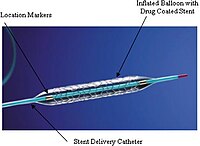
Photo from wikipedia
Endoscopic ultrasound-guided hepaticogastrostomy (EUS-HGS) is indicated for patients with failed endoscopic retrograde cholangiopancreatography (ERCP) [1]. The clinical benefit of EUS-HGS using a long-length, partially covered, self-expandable metal stent (PCSEMS) to… Click to show full abstract
Endoscopic ultrasound-guided hepaticogastrostomy (EUS-HGS) is indicated for patients with failed endoscopic retrograde cholangiopancreatography (ERCP) [1]. The clinical benefit of EUS-HGS using a long-length, partially covered, self-expandable metal stent (PCSEMS) to prevent stent migration has been reported [2, 3]. However, reintervention can be challenging in the event of stent obstruction because biliary access through a long-length PCSEMS is often difficult. Biliary access through the mesh of the EUS-HGS stent may be a useful reintervention technique [4, 5]. In this procedure, insertion of the device into the biliary tract is a limiting step because the lumen of the mesh is relatively narrow. A novel uncovered self-expandable metal stent (UCSEMS) has recently become available in Japan (YABUSAME; KANEKA Medical, Osaka, Japan) (▶Fig. 1). As the diameter of the stent delivery system is only 5.4 Fr and the tip is extremely tapered, stent delivery is performed by insertion along a guidewire. Here we describe the technique of reintervention through the mesh of an occluded EUS-HGS stent using the novel UCSEMS (▶Video 1). A 78-year-old man had undergone EUSHGS with a long-length PCSEMS for duodenal obstruction caused by pancreatic head cancer 6 months previously. Although chemotherapy was performed, obstructive jaundice occurred due to stent obstruction, and reintervention was attempted. After inserting an ERCP catheter into the biliary tract through the mesh of the PCSEMS (▶Fig. 2 a), a 0.025-inch guidewire was deployed. Cholangiography revealed stent occlusion (▶Fig. 2b). The stent delivery system was then successfully inserted through the PCSEMS (▶Fig. 2 c), and the stent was successfully deployed across the stricture site using the novel UCSEMS (8×6cm) with no adverse events (▶Fig. 2d). In the case of occluded EUS-HGS stent, the technique of reintervention through its mesh using the novel UCSEMS appears to be useful and should be further evaluated in a greater number of patients.
Journal Title: Endoscopy
Year Published: 2021
Link to full text (if available)
Share on Social Media: Sign Up to like & get
recommendations!